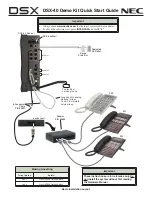
Section 150-231-164
Revision 04
Page 46
5. SYSTEM MAINTENANCE MENU SCREENS
5.01
Figure 15 is the Maintenance Terminal MAIN
MENU Screen. Its eight sub-menus provide
many useful provisioning, test and monitoring tools.
5.02
Selection “H” from the MAIN MENU Screen
allows the Circuit ID# to be set. It is limited to
24 alphanumeric characters. It, like the system settings,
is stored in NVRAM and thus remains when power is
lost. Note that the Circuit ID# is not available at the
HRU-412 Maintenance Port.
5.03
Figure 16 through Figure 19 show the HLU-231
List 6D SPAN STATUS screens for Twin
Doubler applications. The SPAN 1 Screen contains data
on the two HDSL loops between the HLU-231 List 6D
and the first Doubler. The SPAN 2 Screen refers to the
loops between the first Doubler and the HRU-412 for
single-Doubler circuits or between the first and second
Doublers for two-Doubler circuits. The SPAN 3 screen
refers to the loops between the second Doubler and the
HRU-412 for two-Doubler circuits. All status screens
contain the same DS1 interface information.
5.04
Figure 20 shows the SET CLOCK Menu Screen.
Both the Time and Date are set with this menu.
Set the hours and minutes, using the military (24-hour)
convention. Setting the seconds is optional. Enter the
date in the sequence and format shown. List 1 HRU-
412 units having software versions 6.4 and above, and
all List 6, List 7 HRU-412 units can also be set to the
same time and date as the HLU-231 List 6D by entering
a U to the “Update Remote” query. All time information
is lost when power is removed. The last date, however,
is retained in NVRAM and reappears when power is
restored.
5.05
Figure 21 shows the SYSTEM SETTINGS Menu
Screen. All 14 user options can be set from this
screen. To change any option, enter its character key
which is shown inside the parenthesis within each
parameter description. This causes the screen to
refresh with the new. After all parameters have been
selected, press E (Exit) then C (Confirm). The newly
selected parameters are now activated.
5.06
Figure 22 shows the LOOPBACK MENU Screen
for a two-Doubler system. Each of the four
modules can be looped back towards the network or the
customer from this screen. NDU2 & CDU2 are not
available for single Doubler applications and only NLOC,
NREM, CLOC & CREM are available for non-Doubler
applications.
5.07
Figure 23 through Figure 26 show the
PERFORMANCE DATA screens for Doubler
applications. Both the Errored and Unavailable Seconds
for both HDSL loops and each T1 input are listed at 15-
minute intervals over a four hour time interval. The
SPAN 1 Screen contains data on the two HDSL loops
between the HLU-231 List 6D and the first Doubler
(HDU1). The SPAN 2 Screen refers to the loops
between the first Doubler (HDU1) and the HRU-412 for
one Doubler circuits or between the first and second
Doublers (HDU1 & HDU2) for two-Doubler circuits. The
SPAN 3 Screen refers to the loops between the second
Doubler and the HRU-412 for two-Doubler circuits. All
status screens contain the same DS1 interface errors.
Earlier & later data, in four-hour chunks on six different
screens per span, can be accessed by pressing P
(Previous) or N (Next) respectively. Performance data
from the different spans can be accessed by entering S
(Span). All of the counters can be set to “0” by pressing
C (Clear) from the HLU-231 List 6D SPAN STATUS
Screen shown in Figure 16 through Figure 19. Note that
since the HLU-231 List 6D is considered the master
module, this clears all performance data screens at both
the HLU-231 List 6D & the HRU-412. The RS-232
terminal interface at the HRU-412 does not allow the
counters to be cleared.
5.08
Figure 27 through Figure 30 show the 7-DAY
PERFORMANCE HISTORY screens for
Doubler applications. The “Errored Seconds” and
“Unavailable Seconds” for both HDSL loops and each of
the two DS1 inputs are listed for the current and
previous seven days. The SPAN 1 Screen contains
data on the two HDSL loops between the HLU-231 List
6D and the first Doubler (HDU1). The SPAN 2 Screen
refers to the loops between the first Doubler (HDU1) and
the HRU-412 for one-Doubler circuits or between the
first and second Doublers (HDU1 & HDU2) for two-
Doubler circuits. The SPAN 3 Screen refers to the loops
between the second Doubler and the HRU-412 for two-
Doubler circuits. All status screens contain the same
DS-1 interface errors. All of the counters can be set to
“0” by pressing C (Clear) on the HLU-231 List 6D SPAN
STATUS Screen (Figure 16 through Figure 19). Note
that since the HLU-231 List 6D is considered the master
module, this clears
all performance data screens at both
the HLU-231 List 6D & the HRU-412. The RS-232
terminal interface at the HRU-412 does not allow the
counters to be cleared.
















































